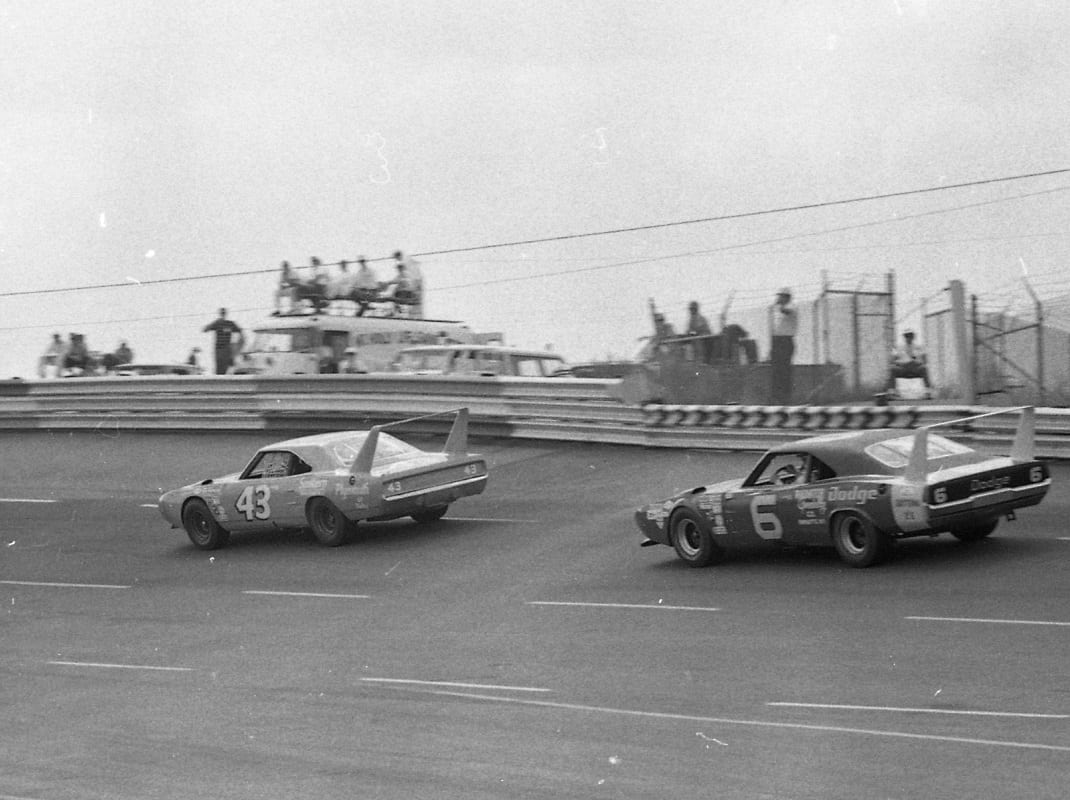This story originally appeared in the Feb. 2014 issue of SPEED SPORT Magazine.
By description, the winged Dodge Daytonas unveiled and tested in early 1969 and originally slated for the 1970 NASCAR Grand National season seemed to have come right out of a science fiction movie.
Their bullet-like front ends and high adjustable rear wings looked peculiar on a stock car and didn’t resemble anything previously used in NASCAR’s 22-year history. Rival automakers considered them a gimmick and a bit eccentric.
Still, their 18-month existence in the sport carved out one of NASCAR’s most interesting chapters of stock car racing.
A step back in time offers insight as to how Detroit’s masterful designers came up with odd, but aerodynamically effective on-track masterpiece.
The phenomenal success enjoyed by Richard Petty in 1967 was directly responsible for the strange and wacky design. Not that he personally developed the blueprint from his own musings, but the fact Petty wheeled Chrysler’s boxy ’66 Plymouth Belvedere to 27 wins in 48 starts that year (10 coming consecutively) was difficult for Ford executives to take.
Amazingly, Petty ran the one car on short tracks, intermediate tracks and superspeedways and tallied 36 victories in 1966 and ’67.
“The Plymouth Belvedere was a special car,” Petty said when the car was presented to the NASCAR Hall of Fame in October of 2008. “Back then we usually found a car that was good on short tracks or speedways or dirt tracks, but not many that were good everywhere. That Plymouth was fast no matter where we ran.”
The “Win on Sunday-Sell on Monday” moniker prompted fans to fill Chrysler’s showrooms to see the car while Ford Motor Co. struggled to generate the same sales excitement.
Petty followed suit again in 1968 with 16 victories in 49 starts, driving a larger Plymouth Road Runner. That particular body style had a problem with the rear end lifting off the ground and made the car uncontrollable at high speeds. Petty crashed hard at Darlington (S.C.) Raceway that year, resulting in a concussion and dislocated shoulder.
That’s when Chrysler’s engineering team, headed by Bob Bromberg and Larry Rathgeb, asked for ideas for the 1969 model, no matter how outlandish they seemed. What developed was the high-standing center horizontal wing adjusted by turns of flush bolt heads — much like raising and lowering an airplane rudder.
For 1969, Ford offered sleek Mercury Cyclones and Ford Torinos that got fans and the media buzzing. Their low front ends, fastback tapered rooflines and nearly horizontal rear windows created a racer’s dream.
The only real difference in the Cyclone and Torino was that the Mercury featured a somewhat pointed front grille, while the Torino carried a flat boxy front.
Ford took its plan a step further by coaxing Petty Enterprises away from their decade-long allegiance to Chrysler. It was a one-year hiatus caused by a directive that left Petty dumbfounded.
Strangely, Chrysler executives told Petty he could only drive Plymouths and not the highly anticipated Dodge Daytonas. Petty told them, “If that’s the case, I’d have to go across the street.”
He went to Ford, causing one of the most explosive announcements in NASCAR history.
The official announcement came on Nov. 25, 1968. Chrysler officials were stunned by his move. It wasn’t until April of 1969 that Petty was given renderings of a newly designed Plymouth Superbird in hopes of getting him back for 1970.
Buddy Baker is credited with topping 200 mph in the Dodge Daytona at Talladega Superspeedway on March 24, 1969, during a Goodyear tire test. Bobby Allison also topped the 200 mph mark during the same test. Charlie Glotzbach ran 200 mph in the car at the Chrysler test track in Chelsea, Mich., in July.
Allison was a huge fan of the winged Dodges and offered great feedback about the car to Chrysler’s engineers.
“The car was really, really stable,” Allison said recently. “Prior to that period of racing, the cars were pretty unstable because no one understood the aerodynamics. They made that pointed nose and didn’t make it all downforce and had a split where some air ran under the car. The wing, as tall as it was, was really good and made the car handle very well. I was pretty impressed and really excited about that car. The first time I saw it, I was just in awe.”
Continued on the next page…
